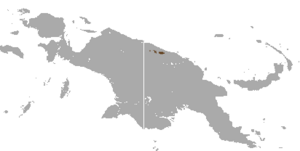Tenkile facts for kids
Quick facts for kids Tenkile |
|
|---|---|
| Conservation status | |
| Scientific classification | |
| Genus: |
Dendrolagus
|
| Species: |
scottae
|
 |
|
| Tenkile range | |
The tenkile (Dendrolagus scottae), also called Scott's tree-kangaroo, is a special type of tree-kangaroo. It belongs to the Macropodidae family, which includes kangaroos and wallabies. This amazing animal lives only in a tiny part of the Torricelli Mountains in Papua New Guinea.
Tenkiles live in warm, dry forests. Sadly, their homes are shrinking because of habitat loss. They are also hunted for their meat. This has made the tenkile an endangered animal. People in Papua New Guinea sometimes hunt tenkiles for food. The number of people there has grown, so more tenkiles are hunted. Also, some tenkiles are caught for their fur or sold illegally as pets. Even pet dogs can hunt them. Logging and farming for crops like coffee and rice also destroy their forest homes.
Contents
What is a Tenkile?
The tenkile is a close relative of Doria's tree-kangaroo. It usually weighs between 9 and 11 kilograms (about 20 to 24 pounds). Male tenkiles are often bigger than females.
These tree-kangaroos are mostly black. They have some chocolate-brown fur on their legs and a long tail. You might notice swirls of hair on their shoulders. Tenkiles have a strong smell. They also have a long snout. Unlike regular kangaroos, tenkiles can hop and walk on two legs. They can even raise their arms above their heads!
Where Tenkiles Live
Tenkiles have a very small home area. They live high up in the Torricelli Mountains, between 900 and 1,700 meters (about 3,000 to 5,600 feet) above sea level. Their total living space is less than 125 square kilometers (about 48 square miles).
They prefer mid-mountain rainforests. These forests have trees like Podocarpus, Libocedrus, Araucaria, and Rapanea.
What Tenkiles Eat
Tenkiles are mainly plant-eaters, also known as herbivores. They eat tree leaves, ferns, and soft vines. Some of their favorite foods include Scaevola and Tetracera.
They look for food both in the treetops and on the ground. Scientists are still learning more about their exact diet. Much of what we know comes from local people who live near them.
Tenkile Reproduction and Life Cycle
Scientists believe tenkiles can have babies all year round. This means there isn't a specific breeding season. They usually have one baby, called a joey, each year.
The mother carries her newborn joey in her pouch. The joey stays in the pouch until it is old enough to leave, which can be up to a year. After leaving the pouch, the young tenkile stays with its mother for about two years before living on its own.
We don't know exactly how long a tenkile is pregnant. However, other tree-kangaroos are pregnant for about 30 days. So, it's likely similar for the tenkile. The mother takes care of the young. Sometimes, groups of a male, female, and their young are seen. Other times, only a mother and her joey are together.
The tenkile's slow reproduction rate is a concern. In 2001, there might have been as few as 100 tenkiles left. With so few animals, it's harder for them to find mates. A slow birth rate also means it takes a long time for the population to grow back after losses.
How Tenkiles Interact
Most of what we know about tenkile social life comes from local people in Papua New Guinea. When tenkiles were first discovered, locals often saw them in groups of four. These groups usually included a male, a female, and their young.
Today, most sightings are of single tenkiles. This change is likely because their numbers have dropped a lot. We don't know much about how they communicate. But it's thought they use all their senses: sight, hearing, smell, and touch. Tenkiles are not usually aggressive towards humans. They tend to stay away from people while in the trees.
Tenkile Status and Protection
The number of tenkiles has dropped a lot in the last 50 years. Their population has gone down by 80% in just ten years. They now live in only three small, remote areas. These are parts of the Torricelli Mountains, the eastern Bewani Range, and the Menawa Range in Papua New Guinea. They are found at altitudes between 900 and 1700 meters (about 3,000 to 5,600 feet).
The International Union for the Conservation of Nature (IUCN) has listed the tenkile as "critically endangered". This means they are at a very high risk of disappearing forever. In the Torricelli Mountains, there are believed to be fewer than 250 tenkiles left. A special agreement, called a moratorium, has been made with local communities in the Swelpini area. This agreement stops hunting to help protect the tenkile.
Conservation Efforts
The main group working to save the tenkile is the Tenkile Conservation Alliance (TCA). This group started in 2001. Their main goal is to protect the amazing variety of plants and animals in Papua New Guinea. They want to make the Torricelli Mountain Range a protected area.
The TCA works with villages near the tenkile's home. They visit schools to teach children about these animals. Thanks to their efforts, 50 villages have agreed to stop hunting tenkiles. This helps save not only the tenkile but also the Weimang/Golden Tree Kangaroo. The TCA has helped local people find other food sources, like rabbits, fish, and imported meat. This has led to a big drop in tenkile hunting for over 10 years.
Another group, the WWF Forest Program (PNG or FoNG), also works on conservation. They aim to increase biodiversity through community programs. They also work with the government and other non-governmental organisations to create conservation plans for all of Papua New Guinea.


